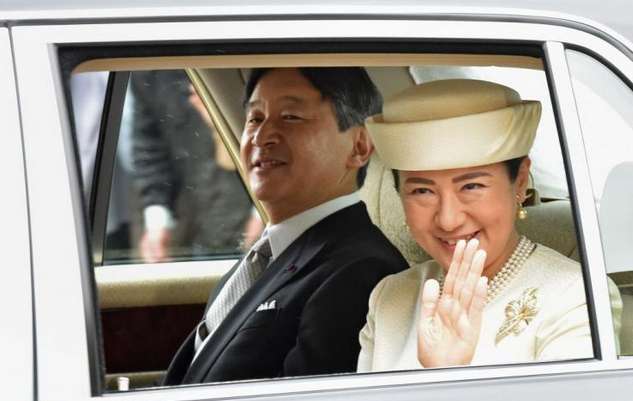
As the last of the cherry blossoms fell in Tokyo, the Japanese gaze turned to the chrysanthemum, that elegant emblem of the Imperial Family. On May Day no less, the Chrysanthemum Curtain lifted – a very rare occurrence – to allow a new emperor to succeed his father, Akihito, as his forebears have done for fifteen centuries. Crown Prince Naruhito became the 126th Emperor.
Just like Rome’s Romulus in 753 BC, and England’s Arthur and his Round Table, there is much myth about the origins of the Chrysanthemums. Could the first Emperor, Jimmu (pictured below as conceived by Ginko Adachi in an 1891 woodblock), really have been the great-grandfather of Ninigi, the grandson of the sun goddess Amaterasu, sent down to earth to plant rice? Or that his sovereignty was assumed bang-on February 11, 660 BC? Or that he reigned for 76 years until his death at 127? Until 1945, emperors sent envoys bearing offerings to Jimmu’s tomb.
In fact, the first twelve Emperors, from Jimmu to Keiko (who died in 130 AD, having fathered 72 sons and eight daughters) are now conceded to be the legendary ones. Certainly, by the reign of Ojin, t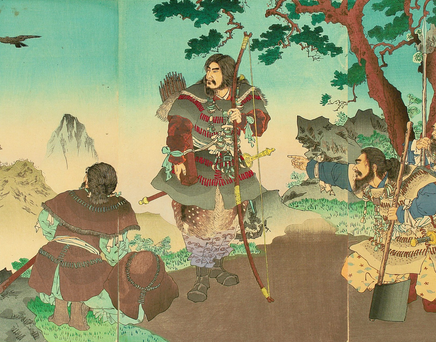 he fifteenth Emperor, who ascended in 270, legend had given way to something more dependable, although dates continue to be unreliable. With Keitai in 507 AD, the 26th and first historical Emperor, emerges. He is described thus: “He loved the people, and was courteous to men of worth. He was of generous disposition.” This could be Akihito, and, coincidentally, Keitai was the first emperor to formally abdicate.
he fifteenth Emperor, who ascended in 270, legend had given way to something more dependable, although dates continue to be unreliable. With Keitai in 507 AD, the 26th and first historical Emperor, emerges. He is described thus: “He loved the people, and was courteous to men of worth. He was of generous disposition.” This could be Akihito, and, coincidentally, Keitai was the first emperor to formally abdicate.
After 30 years, 85-year-old Emperor Akihito had been allowed to abdicate, the first Emperor since Kokaku, in 1817. For Japan’s iron-clad Imperial Household Laws of 1889 and 1947 and the inscrutable, unbending, all-powerful Imperial Household Agency, the Kunaicho, the resignation of their Mikado, was momentous and required two years for the succession to be allowed to take place. It was not just caution but pragmatism that caused the delay. New calendars had to be 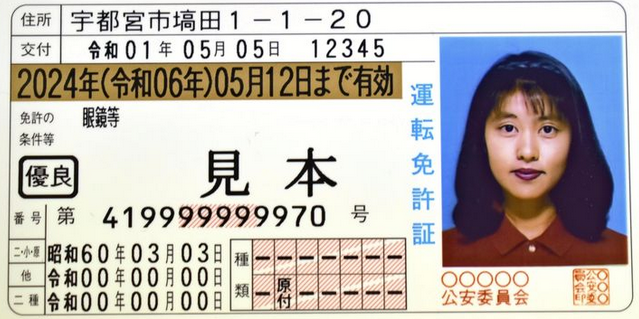 planned. But bizarrely, the name of the new age was not announced until April 1 — barely enough time to mint coins, produce revised driving licenses (at right), and create calendars bearing the name of the dawning era. In its rush to keep up with the times, the city of Koga is said to have erased 1650 water bills! By April 4, a Tokyo factory manufacturing rubber stamps had run out of rubber. In any case, at midnight on the May 1, the Reiwa Era (‘Beautiful Harmony’) will mark the accession of 59-year-old Naruhito.
planned. But bizarrely, the name of the new age was not announced until April 1 — barely enough time to mint coins, produce revised driving licenses (at right), and create calendars bearing the name of the dawning era. In its rush to keep up with the times, the city of Koga is said to have erased 1650 water bills! By April 4, a Tokyo factory manufacturing rubber stamps had run out of rubber. In any case, at midnight on the May 1, the Reiwa Era (‘Beautiful Harmony’) will mark the accession of 59-year-old Naruhito.
The dutiful, decent Akihito was clearly exhausted, like Benedict XVI, who by February 2013 just could not face another trip abroad. Even twenty years ago, Gale Eisenstodt wrote in The Atlantic of “nothing but symbolic drudgery — attesting the appointment of ambassadors and ministers, putting his seal on documents from the cabinet. Every year in early summer the Emperor plants rice at the palace paddy, and the Empress goes off to cultivate silk at the imperial silkworm nursery.”
Despite the fact that Shinto was really a local cult in Japan and, before the late nineteenth century, the imperial house was mainly Buddhist, and, what’s more, the post-Second World War government abolished the link between religion and the State, Akihito spent much of his time praying. As the new emperor, his enthronement involved daijosai — a night spent communing with the sun goddess. On the first of every month and about twenty times a year, Akihito offered prayers at palace shrines. His last act as emperor was to visit the tomb of his father, Hirohito.
It is astonishing to think that it was only on New Year’s Day, 1946, that Akihito’s father repudiated any claim to divinity. It is also astonishing that only six decades before, Count Ito returned from a visit to wily old kingmaker Otto von Bismarck with the message for his monarch, the Emperor Meiji, “Revive those parts of Shinto that exalt the authority and divinity of the emperor.” And so, the remarkable Meiji, both reactionary and modernist, became a living God. This myth somehow survived the reign of Meiji’s sickly, unstable son, Taisho, whose performance at the opening of the Diet, when he rolled the text of his speech into a tube and surveyed them as though it were a telescope, surely stretched the assertion of divinity.
Taisho’s son, Hirohito, born in 1912, was made of sterner stuff. His passivity after 1936 as Japan drifted — and drilled — towards war does not excuse him, and while he rejoiced in his kingdom’s early military triumphs it is still unclear how much he was consulted by his ministers or how much say he had in the war’s conduct. At its end, he told Douglas MacArthur that he accepted responsibility for every act committed in his name during the war and appeared to spend the next 44 years humanising himself. Awkward, shy and lacking small-talk, he became known as ‘Mr Is-that-so’ as he invariably responded to every comment with, ‘Ah, so desu-ka?’ He travelled abroad, braving understandable protests, and immersed himself in the study of marine biology.
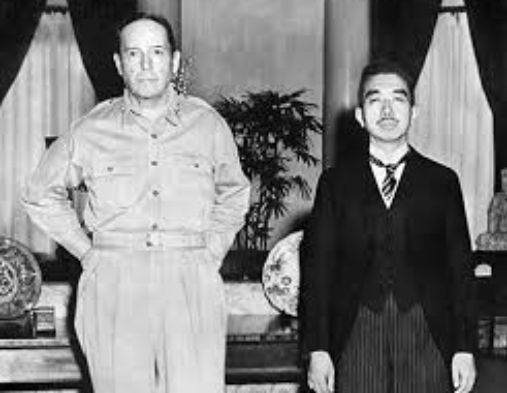
MacArthur and Hirohito in 1947, after the then-emperor renounced his divinity.
What do we know of his grandson, Naruhito, the new Mikado? Australian journalist and foreign correspondent Ben Hills has given an illuminating account in his sensational biography of Masako, the new empress. Firstborn of a love match between then-Crown Prince Akihito and the beautiful commoner Michiko Shoda, Naruhito (‘vast virtue’) arrived in a hastily converted hospital in the grounds of the imperial palace. “I was born in a barn inside a moat’, he would joke. Unlike his father and forebears, who were taken from their parents by the age of three and reared by their court, Naruhito was suckled and raised by his mother. Doting, conscientious Michiko embraced the teachings of that American guru Dr Benjamin Spock and published The Naruhito Constitution, her best-selling guide to raising a rising prince (‘only one toy at a time’, ‘give him a proper hug at least once a day’). Still, life in the East Palace was like a goldfish bowl, with its eight chamberlains, three doctors, three chefs and many servants dedicated to brushing clothes, cleaning shoes and polishing silver.
Naruhito and his violin (later a viola) would join his father on the cello and his mother on the harp or piano, playing Mozart or Schuman. His father lectured him to avoid “a lifestyle which is above the clouds and divorced from the citizens” — ironic advice, as his favourite pastime since childhood has been mountaineering – more as a trekker than alpinist. Is he trying to reach those clouds or simply escape the claustrophobic court? The Kunaicho, it must be said, make life at Windsor look like Glastonbury.
The young prince was, like his father, spared military service, unlike his fellow heirs apparent in Britain, Denmark, the Emirates, Norway, Spain and Thailand. Any thought of conflict or combat has been anathema to Akihito, whose raison d’etre has been peace. After all, especially in the wake of World War Two’s woeful years, Akihito’s era has been Heisei — ‘abounding peace’ – a vision he has pursued with subtle, self-effacing yet steely determination. The closest Naruhito was allowed to get to the martial arts was his school’s annual kendo fencing tournament and watching sumo-wrestling.
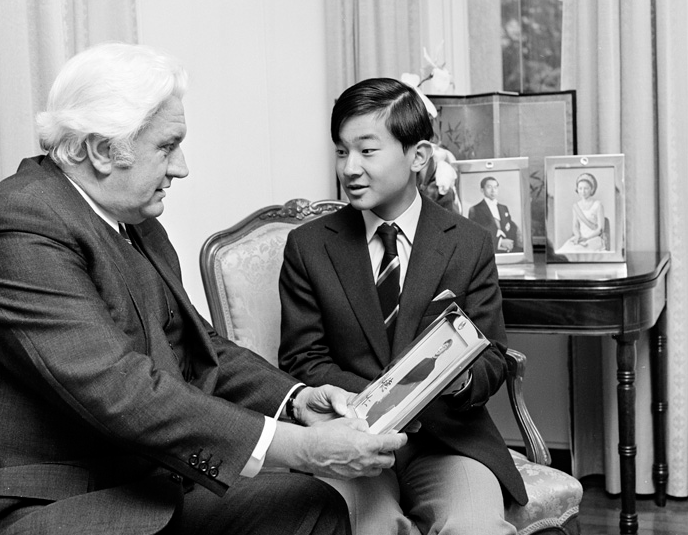 When he was 14, the prince was permitted to leave Japan for the first time, enjoying a home-stay of some weeks in Victoria with the distinguished Australian businessman, Colin Harper and his wife, Barbara. There had been some slight hesitation, as Barbara’s mother and stepfather had been prisoners of the Japanese in Changi and not well treated. In the best Australian spirit, the Harpers and their two sons proved themselves warm and easy-going hosts at home in South Yarra and at their modest beach house at Point Lonsdale. The trip had its highs and lows. He climbed Ayers Rock (as it was) and met Governor-General Sir John Kerr (above at left), for whom he played the violin (Chopin).
When he was 14, the prince was permitted to leave Japan for the first time, enjoying a home-stay of some weeks in Victoria with the distinguished Australian businessman, Colin Harper and his wife, Barbara. There had been some slight hesitation, as Barbara’s mother and stepfather had been prisoners of the Japanese in Changi and not well treated. In the best Australian spirit, the Harpers and their two sons proved themselves warm and easy-going hosts at home in South Yarra and at their modest beach house at Point Lonsdale. The trip had its highs and lows. He climbed Ayers Rock (as it was) and met Governor-General Sir John Kerr (above at left), for whom he played the violin (Chopin).
A diligent if not brilliant student, Naruhito, ate – and drank – with his contemporaries and chose a pedestrian, non-contentious subject for his thesis, ‘A Tentative Review of Maritime Transportation in the Seto Inland Sea in the Medieval Period’. Grandfather Hirohito had devoted the last part of his long life to the study of jellyfish; Akihito immersed himself in the goby fish. Rather poignantly, Naruhito shared with a press conference the reasons for his thesis choice, “I have had a keen interest in roads since childhood. On roads you can go to the unknown world. Since I have been leading a life where I have few chances to go out freely, roads are a precious bridge to the unknown world, so to speak.”
Author Hills also reveals the Prince’s entry under ‘Ambition’ in his university yearbook, “To teach English history at university”. Another poignant glimpse into the life of a reluctant prince? His academic journey continued through two liberating years at Oxford where he studied 18th century transportation on the Upper Thames. In his slight, pleasant, discreet memoir The Thames and I (1993, translated 2006) the Prince wrote of his time at Merton College: washing his own clothes (flooding the laundry with suds), learning to iron a shirt, cycling, pub crawls, inter-college tennis and scaling Britain’s three highest peaks. Western university campuses are generally strangers to deference so when the Prince pointed out that denka was Japanese for Highness while denki is a light fitting, he was promptly dubbed denki by his friends. He also spent time with fellow royals – fly-fishing with Charles; skiing with Hans-Adam; sailing the fjords with Harald; cruising the canals with Beatrix. The memoir, of what was clearly a precious time in his life, ends as he flew home from Heathrow, “A new page in my life was opening, but I felt a large void in my heart and as I stared out of the windows of the plane I felt a lump in my throat.”
He returned to Japan and the moated East Palace in October 1985. In January 1989, Naruhito’s controversial grandfather, Hirohito, died, after 62 years as emperor, having lived long enough to become venerable – at least in Japan. Akihito succeeded, taking his wife and younger two children to the Imperial Palace, leaving Naruhito to himself in the vast and now-empty East Palace. In the summer of 1990, Naruhito’s younger brother, Akishino, married Kiko Kawashima, a professor’s daughter. In 1991, 31 and unhappily unmarried, Naruhito was invested as Crown Prince. According to Hills, Naruhito received ambassadors, attended functions, and took the occasional trip abroad; he laboured over his Oxford thesis and climbed the odd mountain “his only companions his official minders and a straggle of out-of-breath journalists”.
Since his teens, the Kunaicho had, of course, been searching for a match for their Prince, by now the oldest unwed heir in two millennia. The bride-hunting committee kept pushing brown envelopes with suitable names into his hands. But in November 1986, he had met the attractive, clever, multi-lingual diplomat Masako Owada at a palace reception for the Infanta Elena. As he recalled it, “something shot through me the moment I met her”. Overcoming Kunaicho resistance and Masako’s reluctance, they finally wed in June 1993, seven years after first meeting.
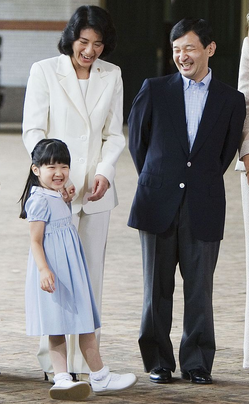 There was much excitement at the new Crown Princess bringing a breath of fresh air to the Chrysanthemums. Of course, this was the last thing the Kunaicho wanted. They sought a demure version of her husband — three paces behind, eyes downcast, gloved-hand waving, silent, fertile – and smiling through it all. What followed were a hellish fifteen years: a denial of any diplomatic role for the young couple; an eight-year wait for a child; and then, as Aiko was a daughter (despite a history of eight empresses regnant, the Meiji and MacArthur ‘reforms’ limited succession to male heirs) there was continued pressure to produce a son (the royal family at right, before Naruhito ascended to the throne ). The result? Debilitating bouts of depression for the princess. Following the birth of a son, Hisahito, to Naruhito’s younger brother in 2006, and years of treatment, Masako is at last, and slowly, emerging to take her place beside her steadfast husband, ‘I will strive to do my best so that I can contribute to the happiness of the people’.
There was much excitement at the new Crown Princess bringing a breath of fresh air to the Chrysanthemums. Of course, this was the last thing the Kunaicho wanted. They sought a demure version of her husband — three paces behind, eyes downcast, gloved-hand waving, silent, fertile – and smiling through it all. What followed were a hellish fifteen years: a denial of any diplomatic role for the young couple; an eight-year wait for a child; and then, as Aiko was a daughter (despite a history of eight empresses regnant, the Meiji and MacArthur ‘reforms’ limited succession to male heirs) there was continued pressure to produce a son (the royal family at right, before Naruhito ascended to the throne ). The result? Debilitating bouts of depression for the princess. Following the birth of a son, Hisahito, to Naruhito’s younger brother in 2006, and years of treatment, Masako is at last, and slowly, emerging to take her place beside her steadfast husband, ‘I will strive to do my best so that I can contribute to the happiness of the people’.
Most indications are that the new Emperor will continue to honour his father’s mission. On his fifty-fifth birthday he observed, “Today, when memories of war are fading, I believe it is important to look back [at] our past with humility and pass down correctly the miserable experience and the historic path Japan took from the generation who know the war to the generation who don’t.”
As for the retired Akihito, he will assume the title of jōkō (Emperor Emeritus) and he and Michiko (jōkōgō) will, once it is refurbished, return to Tōgū Palace, where they first lived. He will have more time for the taxonomy of the goby; while, rather delightfully, the jōkōgō has announced that she is looking forward to diving into Wodehouse’s world of Wooster and Jeeves.
One can only hope the beautiful harmony they sought to bestow on their kingdom will rest on both dutiful father, son and their consorts.
Mark McGinness lives and writes in the United Arab Emirates.
 Sign In
Sign In 0 Items (
0 Items ( Search
Search









Mark,
Japanese culture might still have a way to go, despite the shiny surface. My family hosted a Japanese student for 4-years. She arrived in Year-8. She was horrified at the distorted and defamatory history she was taught in Oz, you know, the one where Japanese soldiers massacred prisoners and civilians and committed atrocities in China. She was well aware of the American ‘war-crime’ of dropping two atomic bombs on non-combatant civilians, but was unaware of the Rape of Nanking, Muar River, the Tol Plantation Massacre or the destruction of Manila (just because they could).
Their war history continues to be faked, though that is also the case in Oz. The difference is they know not of the evil they did, whereas the bleeding hearts in Oz have created a history of evil where little or none existed
Yeah, your story is not uncommon En Passant. In wargaming circles is is quite common to have Japanese players horrified at recreations referencing the ‘myth’ of the Rape of Nanking or of the slaughter of POWs. As for the ‘comfort women’! Ignorance or lies.
whitelaughter,
As a hobby I regularly write articles for three American war game magazines!